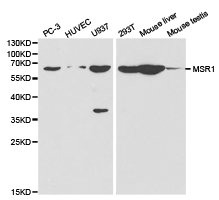
Western blot analysis of extracts of various cell lines, using MSR1 antibody.
MSR1 Antibody
CSB-PA015050KA01HU
ApplicationsWestern Blot, ELISA, ImmunoHistoChemistry
Product group Antibodies
ReactivityHuman, Mouse, Rat
TargetMSR1
Overview
- SupplierCusabio
- Product NameMSR1 Antibody
- Delivery Days Customer20
- ApplicationsWestern Blot, ELISA, ImmunoHistoChemistry
- CertificationResearch Use Only
- ClonalityPolyclonal
- ConjugateUnconjugated
- Gene ID4481
- Target nameMSR1
- Target descriptionmacrophage scavenger receptor 1
- Target synonymsCD204; macrophage acetylated LDL receptor I and II; macrophage scavenger receptor type III; macrophage scavenger receptor types I and II; phSR1; phSR2; SCARA1; scavenger receptor class A member 1; SRA; SR-A; SR-AI; SR-AII; SR-AIII
- HostRabbit
- IsotypeIgG
- Protein IDP21757
- Protein NameMacrophage scavenger receptor types I and II
- Scientific DescriptionThis gene encodes the class A macrophage scavenger receptors, which include three different types (1, 2, 3) generated by alternative splicing of this gene. These receptors or isoforms are macrophage-specific trimeric integral membrane glycoproteins and have been implicated in many macrophage-associated physiological and pathological processes including atherosclerosis, Alzheimers disease, and host defense. The isoforms type 1 and type 2 are functional receptors and are able to mediate the endocytosis of modified low density lipoproteins (LDLs). The isoform type 3 does not internalize modified LDL (acetyl-LDL) despite having the domain shown to mediate this function in the types 1 and 2 isoforms. It has an altered intracellular processing and is trapped within the endoplasmic reticulum, making it unable to perform endocytosis. The isoform type 3 can inhibit the function of isoforms type 1 and type 2 when co-expressed, indicating a dominant negative effect and suggesting a mechanism for regulation of scavenger receptor activity in macrophages.
- ReactivityHuman, Mouse, Rat
- Storage Instruction-20°C or -80°C
- UNSPSC12352203
